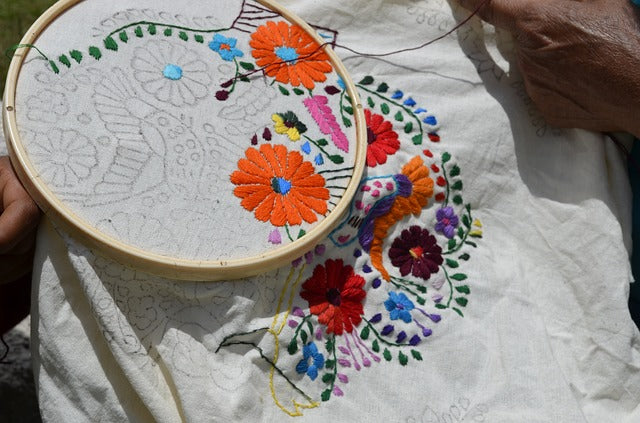
Mexican Embroidery Of Oaxaca
The communal and everyday nature of embroidery in Mexico is enthralling and of particular interest was it’s role amongst women. Many of the artisans had been taught by their mothers and grandmothers from the ages of 5 and 6. The most intricate designs were learned by heart and followed intuitively without patterns. Women spoke of how they began their embroideries at the end of their busy days and it was often a time to relax and meditate. The income that their craft generates gives them financial independence and autonomy, and there were several stories of grandmother’s supporting whole families with their embroidered textiles or women uniting to form co-operatives despite resistance. Each woman described her work with great pride especially the hours invested as well as the significance of the colours, motifs and designs to their culture, heritage and tradition. However, the most touching sentiment that was shared by most of the women was that the embroideries inherently expressed their emotions and feelings and embodied aspects of their personalities, lives and experiences.
In Oaxaca there are many indigenous communities that have kept their textile traditions, from growing the plants to produce threads and textiles, up to the most delicate hand embroidery details. We will be focusing on the traditional embroidery work done in several regions in Oaxaca. Embroidery was traditionally made with the tip of a leaf of maguey or agave, nowadays the steel needle has replaced this ancient technique. However, there is more to this craft than the actual technique: The reason to sew embroidery on their garments is to symbolize different things, sometimes their dreams and aspirations, their life from beginning to end, some others are nature inspired, reminiscent of the wild flora and fauna and green valleys of Oaxaca… Traditional embroidery from Oaxaca is like a clean canvas, ready to be filled with dreams, stories and magic!
The Mazateco community in San Bartolomé Ayautla is one of the indigenous groups that still embroider their traditional clothing by hand. The garments are done in cotton and rayon and use embroidery hoops to trace the outline of the figure and fill with a vertical satin stitch. Embroidery in this community has been sought out since the 90’s, thanks to government and civil organizations helping hands. They also work on different products such as pillowcases, bags and vests.
Another community known for their intricate embroidery is Amuzgo, located in San Pedro Amuzgos in Oaxaca and also in the state of Guerrero. The community located in Oaxaca name themselves as Tzjon Non which means “town of yarn, soft yarn or wick”. They sew their personal dreams and aspirations in horizontal lines across three sectioned huipil –traditional dress-like garment-.
Next up is probably the best known indigenous embroidery known from Mexico, the Zapoteco, which is made up by several communities; we will be addressing two of the ones who make the most delicate and detailed embroidery.
Starting up with the Zapoteco community in San Antonino Castillo Velasco, who are known for an intricate embroidery known as “make me if you can”, a gather stitch that creates pleating on the cotton garment. The white blouse is filled with numerous colorful flowers that remind us of the thick flora of the area.
And last but certainly not least we have the Zapoteco community located at the Istmo de Tehuantepec, women of this community are often called Tehuanas. Their garments are done with dark velvet, big colorful flowers embroidery and silk ruffles on the bottom of the skirt. They also wear a special headdress done with white pleated lace which is starched to maintain its form. This traditional clothing was worn by the famed Mexican artist Frida Kahlo.
These is just the beginning of Mexican Embroidery, given the vast amount of indigenous communities that still handmade their garments; a tradition that has remained since pre-Hispanic times and it has become a trademark of Mexican identity.
We at Mestizo Accent have partner with various hand embroiderers of the Zapotec community from Monte Alban to bring you your own hand embroidered garment!